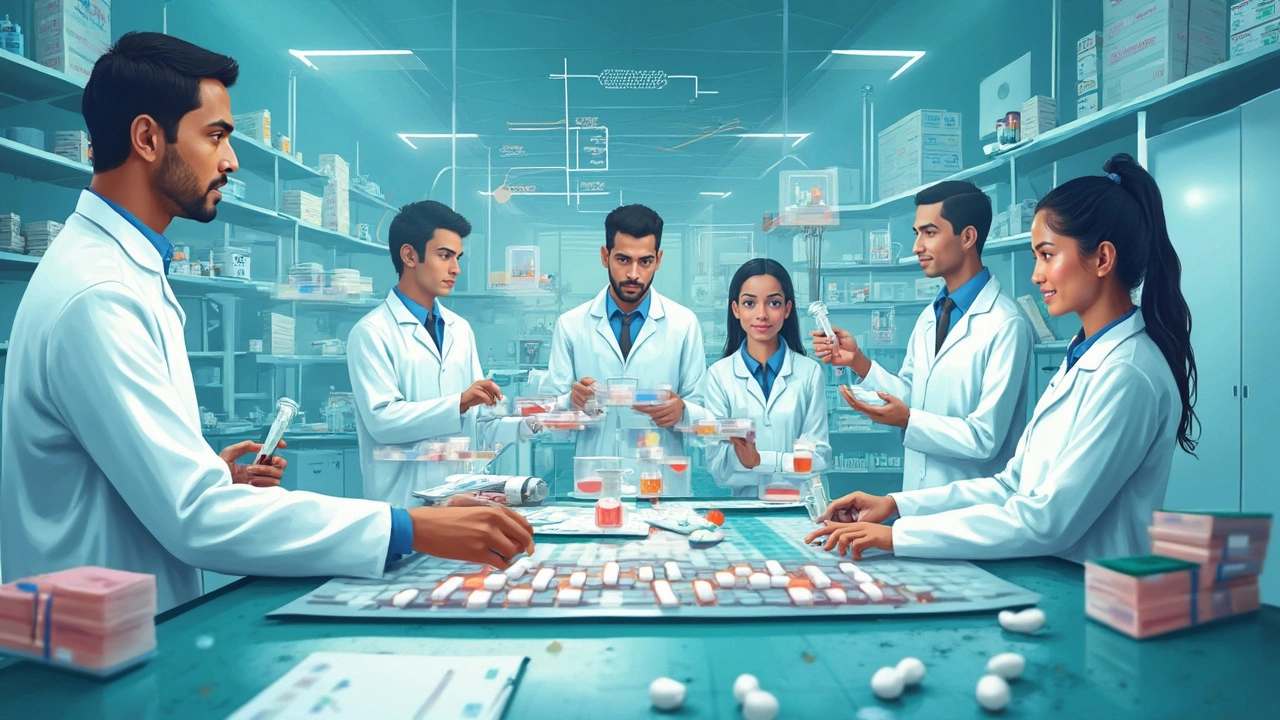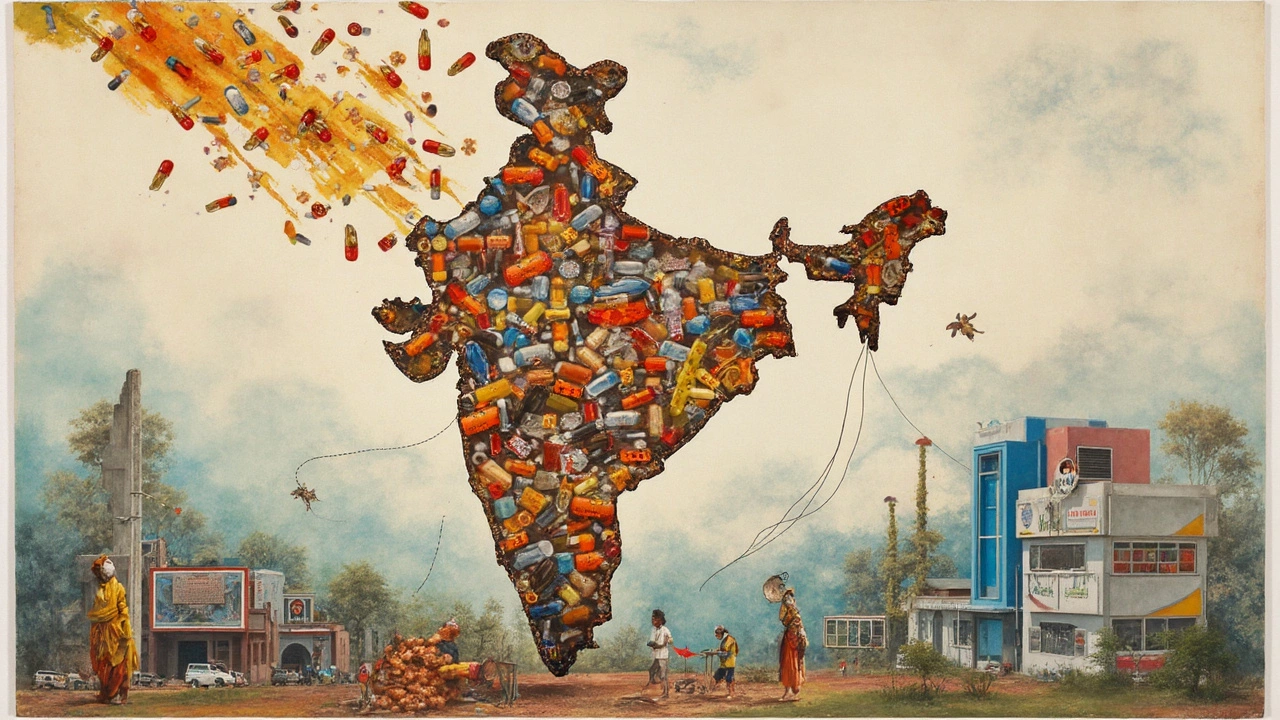Who is the Richest Pharmaceutical Company? The Unexpected Indian Leader

Ask anyone about the wealthiest pharma company in India, and Sun Pharma is almost always the first name that pops up. They’re not just top dogs in India—they’re among the biggest players worldwide. But what does it actually mean to be the richest? Is it about sales, profits, market value, or the sheer scale of influence?
Most people don’t realize just how massive India’s pharmaceutical industry has become. Walk into any pharmacy in Europe or the US, and there’s a decent chance the generic medicine you grab was made by an Indian company. It’s not just about making pills fast and cheap—India’s pharma leaders have figured out how to deliver reliable quality at a price nobody else can beat. That combo is what helps companies like Sun Pharma rake in billions, year after year.
When you start to look at the numbers—sales in the tens of billions of rupees, exports to 100+ countries—the scale gets almost hard to picture. And things are only picking up as India moves up the value chain, putting real money into R&D and tackling the kinds of diseases that matter in the West as well as at home.
- Measuring 'Richest': Money, Market, or More?
- The Indian Pharma Scene: Growth and Giants
- Meet the Richest: Sun Pharma's Rise to the Top
- Why Indian Pharma Dominates Globally
- Quick Tips on Choosing Reliable Pharma Products
Measuring 'Richest': Money, Market, or More?
Richest can mean a bunch of different things in the pharma world. Are we talking about sales numbers, profits, how much the company is worth on the stock market, or maybe how many countries they reach? It’s surprisingly easy to get these mixed up, so let’s break it down.
If you look at annual revenue, you’re checking how much money a company pulls in from selling its medicines every year. For example, Sun Pharma crossed ₹430 billion (about $5.3 billion) in revenue for the financial year 2023-2024, putting it solidly at the front of India's pharmaceutical pack. But revenue doesn’t tell the full story, because high sales don’t always mean high profits.
Net profit is money left after all expenses—taxes, salaries, raw materials, R&D, and more. Some companies like to keep margins fat by focusing on specialty medicines or generics with little competition.
Now, market capitalization is a different beast. This is basically what the stock market thinks a company is worth. As of early 2025, Sun Pharma’s market cap sits around ₹3000 billion, miles ahead of competitors like Dr. Reddy’s and Cipla. Investors look at this number to judge how healthy and strong a company really is over the long term.
- richest pharmaceutical company isn’t always the one with the highest sales. Sometimes it’s about profits or investor confidence.
- Geographic reach matters too. Sun Pharma, for instance, exports to more than 100 countries, and its US operations are a huge piece of its business.
- R&D spending is the hidden engine—companies that invest heavily in research often do better over time, because they develop new drugs and open up new markets.
So when someone asks about the richest pharma company in India, you can say it’s Sun Pharma by almost every measure, but it’s smart to know exactly which numbers you’re looking at.
The Indian Pharma Scene: Growth and Giants
India’s pharmaceutical industry wasn’t built overnight. Back in the 1970s, Indian companies started out copying expensive foreign drugs and selling affordable versions at home. Today, the country’s pharma scene is a global powerhouse, cranking out over 20% of the world’s generic medicines. That’s right—one out of every five generic pills worldwide is made by an Indian manufacturer.
The numbers are wild. The domestic pharma market is worth over $50 billion, and total pharma exports hit $25 billion in 2023. India ships prescription drugs and vaccines to more than 200 countries. During the COVID-19 pandemic, it was Indian firms like Serum Institute and Bharat Biotech that rolled out vaccines at a scale and price no one else could touch. Even the big markets—like the US and Europe—heavily rely on Indian-made medicines for hospitals, clinics, and pharmacies.
Some of the real giants include:
- Sun Pharma (the richest pharmaceutical company in India)
- Cipla
- Dr. Reddy’s
- Lupin
- Aurobindo Pharma
- Zydus Lifesciences
These companies aren’t just making basic meds. They’re spending on research, developing new products, and even buying plants and brands around the world. For example, Dr. Reddy’s and Sun Pharma have grabbed US FDA approvals for complex generics and are moving into higher-value specialty drugs, not just simple knock-offs.
While there’s strong government support and tons of chemistry talent, what really helps India dominate is scale and speed. Indian pharma factories can ramp up production fast—think millions of pills per day—while keeping costs low enough to win big global contracts. If a pharmacy in Liverpool or Cape Town runs out of a common medicine, chances are an Indian company can restock it in a fraction of the time anyone else can manage.

Meet the Richest: Sun Pharma's Rise to the Top
If you want to know who rules the pharma game in India, just look at Sun Pharmaceutical Industries Ltd. Started in 1983 by Dilip Shanghvi with a single psychiatry drug in only five products, they've exploded into a behemoth that's now recognized as the richest pharmaceutical company in the country by far. Over the years, Sun Pharma didn't just grow – they completely reshaped the Indian and global pharma market.
It's not only about selling the most medicines. Sun Pharma made some major moves—like snapping up Ranbaxy in 2014 for $4 billion. That one deal alone created India's largest drugmaker overnight. This aggressive growth strategy meant they leapfrogged rivals and grabbed market share all over the world. Now, they export to over 100 countries and have a strong US presence, which is huge, since American sales make up a big slice of their earnings.
The numbers back it up. Take a look at this quick snapshot of Sun Pharma's scale:
| Year | Revenue (INR Crores) | Net Profit (INR Crores) | Global Employees |
|---|---|---|---|
| 2015 | 27,288 | 4,582 | 30,000+ |
| 2020 | 32,837 | 3,764 | 35,000+ |
| 2024 | 43,886 | 8,340 | 37,000+ |
They're not just pushing generics either. Sun Pharma has put real money into its own research—figuring out new formulas, working on specialty drugs, and even tackling areas like oncology and dermatology where the big bucks are made. That shift has made them a bigger deal in wealthy markets, not just in India.
If you’re wondering how the experts see it, here’s how The Economic Times summed it up recently:
"With its sustained focus on global markets, especially North America, and a knack for strategic acquisitions, Sun Pharma has cemented its place as India’s pharmaceutical powerhouse."
One big lesson from Sun Pharma—being the richest in pharma isn't about sheer volume. It's about playing smart: expanding globally, investing in R&D, and not shying away from bold moves. If you're looking for a company that shows how Indian pharma can lead the world, this is it.
Why Indian Pharma Dominates Globally
If you look at the numbers, India makes around 20% of the world’s generic medicines. That’s more than any other country. Whenever there’s talk of accessible and affordable drugs worldwide, you’ll almost always find an Indian manufacturer in the mix.
So, what’s the secret sauce? A big part of it is scale. Over 3,000 pharma companies and around 10,500 manufacturing units are spread out across India. This isn’t just about quantity—it’s the ability to turn out massive batches of medicines fast and get them out the door cheaper than almost anyone else.
Indian companies figured out the generics game early. When patents expired on popular Western drugs, Indian manufacturers swooped in with quality copies at a fraction of the price. Brands like Sun Pharma, Dr. Reddy’s, and Cipla got global attention by making life-saving treatments for HIV, cancer, and diabetes affordable and available in places where they’d have stayed out of reach.
Tech isn’t missing from the picture either. Indian pharma spends more every year on R&D. For example, Sun Pharma poured about $480 million into research in the last year alone. Indian scientists now lead the charge in developing biosimilars, complex generics, and even new drugs, not just copying the old ones.
Regulation used to be a worry, but times have changed. Most facilities making medicines for export now hold approvals from global bodies like the US FDA or the European Medicines Agency. That means their standards match what you’d expect from any top-tier lab in the West.
If you’re picking a pharma manufacturer in India, odds are high you’ll find brands on your shelf in New York, London, or Nairobi that were made in India. The country’s mix of scientific know-how, smart regulations, and plain-old grit explains why things aren’t slowing down anytime soon.

Quick Tips on Choosing Reliable Pharma Products
Picking the right medicine isn’t just about the brand name you see on the box. It’s about safety, quality, and making sure what you’re taking actually works. India is home to some of the world’s biggest pharma manufacturers, but not all products are created equal. Here are some down-to-earth ways to make sure you’re choosing wisely.
- Check for certifications: Look for medicines that are approved by India’s CDSCO (Central Drugs Standard Control Organization), the US FDA, or the WHO. Big players like Sun Pharma and Dr. Reddy’s often export drugs that meet global standards—those logos or mentions can signal solid quality.
- Scan for batch numbers and expiry dates: Real, reliable medicines will always list batch numbers and clear expiry details. If these aren’t visible or look tampered with, that’s a big red flag.
- Trust established brands: While lesser-known companies might offer cheaper options, sticking with the major names—Sun Pharma, Cipla, Lupin—can lower your risk of getting counterfeit or subpar products. These companies supply to over 100 countries, so they invest heavily in quality control.
- Ask your pharmacist: Don’t hesitate to ask which brands they recommend and if they’ve had issues with certain products. Pharmacists see the good and the bad every day—they know which companies deliver consistently.
- Look at packaging quality: Fuzzy printing, weird misspellings, or poor-quality blister packs usually mean something’s off. Top pharma companies spend a lot on packaging because it protects the drug and their reputation.
Here’s a quick comparison table of key stats from the largest Indian pharma companies exporting to the world:
| Company | Global Approvals (US FDA, WHO GMP) | Markets Exported To | Annual Revenue (2024, INR crores) |
|---|---|---|---|
| Sun Pharma | Yes | 100+ | 45,000+ |
| Cipla | Yes | 80+ | 23,000+ |
| Dr. Reddy’s | Yes | 50+ | 25,000+ |
The bottom line? Go with a richest pharmaceutical company like Sun Pharma or another trusted name if you want proven safety and results. You don’t have to gamble with your health—just keep your eyes open for these simple clues.